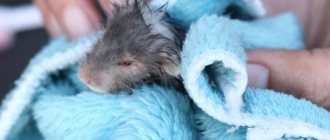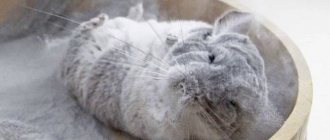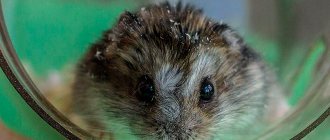The hamster is one of the cutest and friendliest pets. The hilarious behavior of this animal, its funny face and beautiful fur evoke affection in both children and adults.
Those who decide to have a rodent in their home need to study the rules for caring for it in advance. One of the key questions is how to wash a hamster?
Actually, I’m white... Well, that’s how it happened!
The dangers of frequent bathing for hamsters
Frequent bathing greatly shortens the life of a pet. Hamsters don't like water. They are not adapted to stay in liquid, even if it is short-term. Their fur is not thick and dense enough for rodents to quickly warm up. The hairs are not covered with water-repellent secretion.
The protective layers of the skin are delicate, so even after drinking water there is a risk of health problems. Additionally, water procedures can cause injury.
Stress when immersed in water
Hamsters can't swim. For them, immersion in liquid is fraught with death, especially if there is no way to stand on their paws. In water, the animal loses control over the situation; it has no chance to escape without the help of its owner. For this reason, rodents become very nervous. They break out, bite and cling to clothing. Under extreme stress, a heart attack can occur. Even if the pet survives, sometimes after shock it refuses water and food, becomes lethargic, and hides in shelters. In severe cases, the rodent becomes exhausted and dies.
Risk of hypothermia
Hamsters are not adapted to swimming. Their anatomical features do not provide protection from liquids. Trying to wash your pet can result in hypothermia, weakened immunity and pneumonia. Some owners, realizing this, try to dry the animal's fur with a hairdryer. You can't do that. The device frightens the pet, which increases stress. Excessively hot air can cause injury.
Trying to wash your pet can lead to hypothermia.
Violation of the protective layer of the skin
Since hamsters in the wild do not have to deal with water often, the protective layer on their skin is delicate, unstable, and easily destroyed. The liquid partially washes it away, which weakens the animal’s immunity. Due to the lack of a protective layer, skin problems arise. There is a possibility of hair loss.
Bathing with detergents is the most dangerous, especially if we are not talking about a special shampoo for hamsters, but about human shampoo.
Possible injury
The animal, sensing danger, instinctively breaks out and bites. If the owner drops the pet, the latter will fall either into the water or onto the floor. In the first case, the rodent swallows water and may drown. In the second, there is a risk of damage to internal organs and the spine. This can lead to the death of the animal.
Why is washing in water dangerous?
Incorrect, frequent bathing of hamsters results in serious consequences. The main disease of the rodent is hypothermia. The reasons lie in human carelessness and inattention. For example, the hamster got water in its ears or nose, or it was not dried well.
If the animal sneezes often, rubs its nose with its paws, mucous discharge protrudes from the nasal cavity, and the fur around the eyes is wet, then the hamster has a cold. Hypothermia is accompanied by pneumonia. Failure to contact a veterinarian in a timely manner will result in death for the pet, and in regret and bitterness for the person.
Does your hamster have a cold?
When is bathing necessary?
Before swimming, the benefits and risks are first assessed. If the first one outweighs, the procedures are carried out.
You can bathe your hamster in the following situations:
- The rodent got dirty in some food products. We are talking about foods that are prohibited and potentially dangerous for the hamster, such as mayonnaise, honey or jam. While such substances are on the rodent's fur, it can lick them off during the process of self-cleaning. In large quantities, the products will cause poisoning or death of the pet.
- The pet has stained its fur with chemicals. This is an even more dangerous situation. Most often, disinfectants and detergents end up on rodent fur. When they enter the stomach, they not only cause poisoning, but also injure the delicate mucous membranes of the gastrointestinal tract. The risk of developing chronic pathologies increases.
- The animal has parasites. Hamsters are sometimes bothered by parasites and mites. This happens rarely, but the chance remains. In this case, it is better to wash your hamster than to allow it to suffer from bites and risk infection. For the procedures, a special anti-parasite shampoo is used.
You can bathe your hamster if the rodent has gotten dirty.
Do hamsters like to swim?
Syrians and Dzungarians simply love to swim!
Swimming is great, the water is warm... Yeah, of course. Come on, go to the bathhouse! I wish I could come here again. I just got cold and wet.
Just not in the water, but in the sand. Special sand for bathing rodents is sold at any good pet store. It is necessary to ensure that it is sand and not dust. Different sand mixtures are sold for different animals. You will also need a small container, which needs to be filled 2/3 with sand, and it must be sterile.
Sand! Do you hear, owners? Only sand! Get into the bath yourself, I didn’t sign up for this.
Do not use sand from the street, it is so easy to infect a hamster with anything, and large grains of sand will cause discomfort to the animal and can injure it.
Experts do not recommend bathing a hamster in chinchilla sand. Small particles of sand mixture can cause pneumonia. It is better to look for special sand for hamsters.
There is no need to keep a sand bath in the cage all the time. The animal will quickly scatter it. Have sand bathing twice a week.
Place the container with sand in the cage, in a familiar environment familiar to the animal, to avoid stress. If your Syrian or Djungarian doesn’t want to take a bath, don’t worry. They are curious and cautious. Khoma will examine it, see if it is possible to escape in a moment of danger, and try a bath on the tooth. After some time, the hamster will learn to use it.
Often, instead of bathing, the animal goes there to the toilet. It is important to gradually let him understand where the toilet is and where the bathing area is. Sand for bathing must be placed for a certain time and then removed.
When can you do without washing?
You should not bathe your animal as a preventive measure or for your own peace of mind. Rodents do not need daily baths. They have no need to bathe in water; they cleanse themselves in other ways. Pets also do not experience pleasure from the process, so their quality of life will not deteriorate without the procedures.
There is no need to bathe if there is a bad odor. On the contrary, it may worsen the situation. Normally, your pet should not have any odor. The animal carefully cares for its fur, devoting several hours to it every day. Most often, the source of the unpleasant odor is bedding, bowls, stale food supplies, etc. In this case, it is enough to clean with water and a soft sponge.
An unpleasant odor from the pet itself is a sign of illness. Even if the animal has simply stopped caring for itself, you need to contact a veterinarian. The smell can also come from fur, secretions, etc. In this case, the situation is worse, since it is a symptom of a dangerous pathology. You should not bathe an animal if you suspect a disease: this will worsen the general condition and accelerate the course of the disease.
How to get rid of dirt without water?
As noted above, the reason for bathing a dwarf must be serious. And in many cases, you can clean your pet without taking a “bath”:
- If you notice an unpleasant odor from the hamster’s habitat, then you should bathe the cage, not the hamster. Just change the bedding, thoroughly wash the accessories, clean the toilet area daily - and the unpleasant odor will disappear.
- If the dzhungarika seems dirty and greasy at six, or there are pieces of food or feces stuck to it, then there is no need to take water procedures. Sand baths will help cope with such contaminants.
- If candy, chewing gum or glue is tangled in a dzhungarik's fur, then it is enough to cut off the affected area of fur.
- If a rodent gets dirty with food and cannot deal with the contamination on its own, you can wipe its fur with a damp cloth or cotton swab.
If skin diseases are present, many experienced rodent veterinarians will prescribe medications that do not require washing your pet. For example, sprays and injections.
Article on the topic: Why the hamster does not sleep in the house or does not leave it, how to calm the hamster at night
Features of bathing for different breeds of hamsters
When bathing, you need to take into account the characteristics of different breeds. Some are more likely to encounter water, others almost never encounter large open sources, so their fear is genetic. Another problem is the anatomical structure. Dwarf hamsters are easier to injure, so you need to be especially careful with them.
Syrians
The Syrian hamster has difficulty with bathing. It should be washed as quickly as possible, but without a strong stream of water. The animal should not be allowed to swim even in a shallow container. Syrians have weak immunity, so they can become cold and get sick. If the animal is not afraid of noise, you can dry the fur with a hairdryer on low setting.
Otherwise, wrap your pet in a towel to quickly warm him up. At the same time, this will help remove excess liquid.
Dzungariki
Problems rarely arise with this breed, since bathing a dwarf hamster is not difficult. Some animals are even happy to be in the water. Representatives of the breed have short fur, so the risk of catching a cold is lower. After the procedures, remove any remaining moisture from the fur coat with a napkin or towel. The immunity of Djungarian hamsters is stronger than that of Syrian hamsters, but after bathing it is better to remove the cage from drafts.
Djungarians have strong immunity, so the risk of catching a cold when swimming is lower.
Matching
When breeding Syrian hamsters, the correct selection of a pair is important.
To do this, you must follow the following rules:
- select only healthy animals;
- bring together individuals of the same breed;
- avoid inbreeding;
- do not allow animals that suffer from obesity to mate;
- choose hamsters with a friendly disposition.
Mating of Syrian hamsters is best done on neutral territory, where the animals will not defend the right to ownership. You can also place the female in the cage with the male. This will prevent the female from showing excessive hostility, and the male will calmly approach her to mate.
How to properly wash a hamster at home
For the first time, it is recommended to call an assistant, since washing a hamster at home is not easy. He may try to slip out of his hands.
Preparing for a swim
Before bathing, it is recommended to check your pet's reaction to water. You can even try to train a rodent. To do this, carefully take it in your hand and bring it to the container. The water level should not be higher than the animal's paws. If your pet is under severe stress, squeaks, breaks out and bites, you will have to wash it with your fingers dipped in water without immersing it in a container.
What is necessary
For swimming you only need a container and towels. It is advisable to take a small piece of fabric and cover the bottom of the “bathtub” with it. Thanks to this, the hamster will not slide, which will make him a little calmer and partially prevent injury.
It is not recommended to use shampoo. It is difficult to wash it off well, especially if the animal is under severe stress. Incomplete removal of detergents from wool is fraught with poisoning.
In most cases, there is no strict need to use shampoo.
Bathing process
The hamster is placed in a container with a small amount of water. It is carefully washed with your fingers, wetting the dry areas of the coat. If the animal is accustomed to a brush, you can use it. The areas of the ears, eyes and head should be avoided. When fluid gets into the ear cavity, otitis media develops.
The bathing process takes place in a small container.
It is forbidden to rub vigorously or use a rough sponge during the process. This can injure your pet. At best, you will damage his skin and provoke the development of dermatitis, at worst, you will injure him. You need to hold the hamster not too tightly, but not too weakly either: the animal can escape.
Drying the animal
After bathing, the hamster is dried with a soft cloth. It is carried out along the direction of hair growth. The animal is then wrapped in a dry towel and kept there until completely dry.
It is advisable to keep your pet busy with treats to reduce stress levels.
How to dry an animal?
To prevent your Homa from getting sick after a “bath,” you need to dry his fur well. But don’t try to do this with a hairdryer: the noise will scare the animal, and the hot air flow will dry out the skin.
First, you need to wrap the animal in a highly absorbent cloth or towel and blot the liquid. After this, the wool will remain damp. Place the homa on a dry towel and repeat the procedure, lightly pressing the fabric with your fingers, so the moisture will be absorbed better.
When the fur becomes barely damp, you can put your pet in a cage with fresh bedding on a dry cloth. Place the cage in a warm place for a couple of hours, for example, near a radiator.
Rodents bathing in the sand
Sand bathing is the safest and most natural alternative. The material cleanses wool well from stubborn dirt. During the bathing process, the pet experiences pleasure. The material is not capable of harming the animal.
For swimming you need to buy special sand. It must be intended for hamsters. You should not buy sand for chinchillas: it is fine-grained, so it can get into the animal’s respiratory tract. It also does a worse job of cleaning hamsters' fur.
A small amount of sand is poured into a container and placed in the cage. After this, the hamster will become interested in the new product and begin to bathe. After cleaning is completed, the container is removed. Otherwise it will turn into 2 toilets.
Sand alternative to swimming
In nature, animals love to frolic in the sand
, swimming is a lot of fun. To prevent severe contamination of the animals' fur, you need to from time to time place a box of sand in the hamster's cage, in which he will constantly bathe.
After a quick wash in the sand, it is recommended to remove the bathing vessel. At the same time, you need to comb out sand from your pet’s fur with brushes. This procedure will greatly help the natural cleansing of the hamster's fur.
Sand requires the most purified composition, you can add talc there
for better glide.
Whether or not to wash your pet is up to each owner to decide for himself. Before bathing your animal, weigh the pros and cons. It may be enough to simply wipe the hamster's skin thoroughly with a damp cloth and the dirt will disappear.
Hamsters are by nature very neat and clean creatures - they brush their fur 3-5 times a day and constantly “preen themselves”. It is highly undesirable to wash hamsters! The process itself and its consequences, without exaggeration, are dangerous to the life of a hamster. Washing a rodent is fraught with serious stress, from which the hamster may not recover. The washing process itself (usually beginners try to do this under running water) is risky - the hamster desperately resists and can get injured, dislocated, or even slip out of your hands when wet. In addition, washing is dangerous due to one hundred percent violation (complete washing away) of the special thin protective layer of fat on the hamster’s skin. The result is no immunity, no health: after washing, rodents are likely to get at least a cold, or at most pneumonia. And as you know, it is very difficult to cure colds in rodents. After such arguments, do you still want to wash your pet? Some owners go even “further” - they pour water into a plate and “teach the hamster to swim,” after which they photograph the “process” and post it on social networks. This is a form of mockery of the one you tamed! Rodents in nature will never voluntarily wet their fur, much less “swim.” Do not experiment on those who trust you and whose lives depend only on you!
So, take it for granted that hamsters cannot be washed. But what to do if the animal does not look very neat, as if slightly “greasy”? Perhaps a dirty coat may indicate that you are not changing the bedding in your hamster's cage often enough. Untidy fur can also be a symptom of ill health, so it wouldn’t hurt to show your pet to a veterinarian, or analyze your hamster’s diet - are you feeding it correctly, does it have enough water and vitamins? If the hamster is healthy, then you can make the fur look more presentable with sand bathing. Give your hamster the opportunity to clean his coat in sand - pour it into a plastic container with a layer thickness of about 1.5-2 cm and place it in the cage. Most animals will happily have a fun romp in the sand, spin around and preen themselves “along the way.” True, you shouldn’t leave the sand bath in the cage for a long time - hamsters may choose it as a convenient toilet and start marking.
If the hamster gets really dirty (for example, with jam, children's paints, ordinary dirt - you never know where a hamster can accidentally get into), you can clean it easily and safely using ordinary (not perfume!) sanitary wet wipes. It is better to choose baby wipes with a neutral scent. Use gentle stroking movements to remove dirt, changing wipes frequently. You can use cotton pads moistened with warm water and lightly wrung out. Have the dirt been removed? Dry the hamster's fur and avoid opening the windows for at least 3-4 hours to avoid catching your pet's cold. Long-haired hamsters can be combed with a special comb, and short-haired ones can be combed with a regular toothbrush.
Is it possible to wash Djungarian hamsters with water?
Like many other furry animals, hamsters can clean their coats on their own. They themselves are clean, and lick their fur several times a day.
However, there are situations in which this is not enough to cleanse yourself of obsessive dirt. The owner of the hamster should be prepared in advance for this and know what to do in such cases.
Djungarian hamsters are mostly steppe animals. They are more hardy than the Syrian ones. And yet, even a small draft can cause unpleasant diseases to such a small organism.
Bathing hamsters in water is acceptable if the procedures are short-lived and carried out only when absolutely necessary, when other cleaning methods do not help.
When you decide to bathe your little pet and warn against possible illnesses, do not forget to take into account all the recommendations that are outlined below.
Do rodents like to bathe?
Representatives of the order Rodents do not like to swim in water. The exception is animals for which shallow rivers and reservoirs are a place for hunting. Wild hamsters generally try to stay away from water. Their limbs are not adapted for rowing, and the high frequency of respiratory movements does not allow them to hold their breath for a long time under water. That is, wild fluffies will only go into the water if there is a threat to their life, for example, during forest fires or at the sight of a predator.
But is it possible to bathe hamsters in water if they are pets? Is it necessary to wash an animal if it suddenly begins to smell unpleasant? Since all known domesticated breeds are quite close in habits to their wild relatives, they also strongly dislike water. Moreover, the kids are terribly afraid of her. There are, of course, exceptions when these funny animals bathe with pleasure, but frequent contact with water can harm their health.
Harm from frequent water treatments
Many hamster owners mistakenly think that rodents love to spend time in water, but this is completely wrong. Of course, it is not difficult to teach a hamster to swim just by placing it in a shallow container. The rodent will be forced to swim, but this will not happen from the desire to splash around.
The animal's self-preservation instinct simply kicks in. Afraid of drowning, the baby begins to move his little paws as quickly as possible. In this case, they can be compared with representatives of cats, because they also hate water, however, if necessary, they are able to swim.
Of course, the character of each animal is individual, and there may be some that really like water procedures. However, this does not mean that it is acceptable to allow your pet to spend excessive time in the water.
And it’s not just about the possibility of getting hypothermia and a subsequent cold. There are other equally important reasons.
The body of such a small creature is, in principle, not designed for such an activity as swimming. The load received during swimming, coupled with the stress experienced, will have a negative impact on the animal.
In some cases, the animal goes into cardiac arrest. Any stress leads to poor health; even seemingly minimal harm will ruin the animal’s quality of life.
A responsible owner must pay enough attention to his pet and notice the slightest changes in his behavior or appearance. If you notice that the hamster has begun to wash itself in the water, it is better to stop bathing immediately.
Washing a rodent using cosmetic pads and wet wipes
In addition to classic bathing and sand, you can wash your pet using cotton pads and wet wipes. The disc is very simple to use: moisten it in water and rub it over the contaminated area with light stroking movements.
You need to use napkins the same way. But there is one important point here: they should not contain alcohol or any kind of chemical elements that can ruin the hamster’s fur and damage the skin. The ideal option is to wash with baby wipes.
As with bathing, after wiping with napkins or discs, the coat should be thoroughly dried with a towel. If this is not done, the pet may get sick.
On behalf of the entire hamster family, I express my gratitude for not throwing it into the bathtub! Or much worse...
Is it possible to eliminate pollution without resorting to bathing with water?
The Djungarians themselves are quite clean creatures and for the most part they do not need human help to cleanse themselves. And yet, once a week you can make sand baths, for which you should use a special container. In the wild, hamsters use just this method of bathing rather than water.
If you notice that there is dirt on the hamster's fur, take a wide brush (a hair coloring brush or an art brush made of dense bristles is suitable) or an ordinary toothbrush. Moisten it a little, gently and slowly move it over the animal’s fur. After finishing the procedure, wipe with a towel. You should not bathe your hamster in water again, as this may make him sick.
What to pay attention to before swimming?
To avoid causing physical harm and to avoid severe stress, follow these bathing rules:
- Heat the water to 30 – 35 degrees before washing your hamster. If it is colder, the pet may catch a cold; hot - get a heart attack.
- Be careful not to get water into your eyes or ears.
- Prepare a towel and hairdryer in advance. After the bath, the animal needs to be dried as quickly as possible, otherwise it may get sick.
Important: under no circumstances should you use regular soap or shampoo. A hamster can only be washed with a special detergent sold in pet stores (if you can’t find one for a hamster, buy one for a rabbit or rodent - it’s also suitable). This is due to the fact that the acid-base balance of human and rodent skin is different. Because of this, when using the wrong shampoo, the rodent’s protective fat layer is disrupted, which leads to dermatitis and scratching, in place of which purulent wounds form.
Sequence of actions when bathing a Djungarian hamster
We wet the Djungarian hamster
The hamster should be placed on a flat surface, and then water at room temperature should be poured on top. Try not to wet the animal’s head and especially the animal’s ears and nose. It is highly undesirable to wash your pet with tap water in order to avoid unexpected temperature changes. And a slippery sink is not the best place for washing.
Soaping a Djungarian hamster
Shampoo in its pure form is completely unsuitable. Just a drop is enough to be diluted in water. Appear with foam and lather the wool with massaging movements. This is done with your fingers, without using a washcloth or sponge.
Rinsing a Djungarian hamster
After using shampoo, the coat and skin are thoroughly rinsed with water to completely rinse off the detergent. Pay special attention to this, if particles of shampoo remain, the animal may accidentally lick it off and get an upset stomach.
Summary
So, is it possible to wash hamsters with water? The answer is yes, but quickly, very carefully and only in extreme cases. In general, bathing procedures should be avoided, since neither the Dzungarians nor the Syrians are adapted to them (the latter in particular). To wash your hamster, use special sand from a pet store - this will almost always be enough.
Do you have any questions? Be sure to ask them in the comments, we will add the answers to the article. And subscribe to notifications about updates, otherwise you will miss a lot of interesting things!
How do dungarians swim in the sand?
Calling a hamster a pet is only partially true, because it is not at all difficult to find it in the wild. As a rule, these are inhabitants of the steppes and some desert regions. It's no surprise that they like to spend a lot of time bathing in the sand.
In addition, bathing your pet in the sand will be the best alternative to swimming in water. Carrying out such procedures is not at all difficult: just place a small bowl or box of sand directly into your pet’s cage.
When the hamster has had enough of bathing and playing in the sand, the container is removed to prevent contamination from appearing in it. As an addition, you can go over the fur with a brush so that the sand remaining on the hairs and skin does not interfere and does not cause irritation.
This method, for the most part, does not cause any harm to the pet, perfectly removes dirt and is generally quite simple, and will not bring any special costs to the owner.
But it’s worth saying that you don’t need to use it too often: by constantly being in the sand, the hamster runs the risk of inhaling small grains of sand. Bathing should occur 1-2 times a week, not more often.
One way or another, before you start washing the animal, it is better to first coordinate this issue with a veterinarian. He will clearly explain what contraindications to bathing may be and give useful recommendations, so that your pet will remain not only clean, but also healthy.
Rules for caring for hamsters
If you want to have a living creature at home that is interesting to watch and does not require special care and walking, then a hamster fits this category perfectly.
The only troublesome point is that all hamsters are active at night, so at this time of day they will fuss, puff and even squeak. They don’t need your attention at this time, so you can simply move the cage to another room.
The hamster is a nocturnal animal. At this time of day he is very active.
Choosing a house
You should not place your new pet in a bottle or aquarium - such dwellings are poorly ventilated and quickly “suffocate”. Moreover, due to stale air, your little friend may get sick.
Whether it's better to buy a cage—with or without bells and whistles—depends on your financial situation. The hamster will feel comfortable in a warm, clean and dry home, and all the play equipment is an optional nice addition.
Note! A cage with tunnels is much more difficult to clean properly. Plus, the hamster will use the tunnels as a food storage facility, and his house will have to be cleaned more often.
If you are getting a mixed-sex couple, then you need to buy a cage of such a size that each pet has personal space.
A hamster is a burrowing animal, so paper (not newspaper, as printing ink releases a toxin that is dangerous for a small animal) or sawdust is suitable as bedding. You can buy special litter for rodents in pet stores - it absorbs moisture well and prevents the spread of odor.
Nutrition
The hamster will try everything you offer him, but it is best to feed him a special mixture that contains all the nutrients and vitamins the animal needs. Periodically, 2-3 times a week, you can pamper your pet with fresh vegetables and fruits. Try to use ripe hard fruits for treats - cucumber, apple, pumpkin. You can give greens.
A hamster can eat anything, so it is important to carefully monitor its diet.
Sweet, soft fruits will stain the cage and animal, and can also cause diarrhea. Sweets, chocolate, baked goods are strictly contraindicated for rodents.
Don't forget to drink! There should always be a drinking bowl filled with fresh water in the house.
Your hamster should always have a drinking bowl with fresh water.
Conclusion: the hamster is clean, unpretentious in food, and does not require special care. You can bathe your hamster, but you don't need to.
Don’t forget – the health and long life of your beloved pet is in your hands.
Important! A hamster is not a soulless toy, but a living, thinking creature, and before you get one, think about whether you can surround the animal with care and love. If yes, then you will get a cute, cheerful animal that will bring joy to your home.
First aid
To maintain immunity, treat your rodent with vitamins. Add a water solution of echinacea to your drink. Infusions of coltsfoot and nettle leaves help with sneezing and coughing. Inject the liquid into your mouth with a syringe or pour it into a drinking bowl. Buy vitamin drops at the pet store and mix them into your food.
Treatment of a runny nose in a hamster involves cleaning the nose with a swab soaked in furatsilin or a 2% solution of boric acid or chamomile decoction. Try instilling streptocide. Dissolve half the tablet in a glass of water, irrigate the mucous membrane with one drop three times a day.
Disinfectant liquids are also suitable for washing watery eyes. For purulent conjunctivitis, use eye drops "Albucid" or "Floxal", "Tobrex" with antibiotics. Through the nasolacrimal duct, the medicine enters the nose and has a therapeutic effect.
How to bathe hamsters correctly
Since the usual habitat of hamsters is the steppe and desert, it should be understood that swimming in water in such an environment is almost impossible. Therefore, when answering the question of whether hamsters are washed, it should be emphasized that real bathing with water is not advisable for a hamster.
In order to clean the rodent of dirt, a simpler and less stressful method may be suitable. To do this you will need a damp cotton swab. It is best to keep the napkin warm. Cotton wool and simple wet baby wipes without chemical impregnations are also suitable. Take the rodent in your hands and wipe it thoroughly with a napkin; if the pet is very dirty, repeat the procedure several times.
After washing, dry the fur well and place the rodent in a warm place so that it does not catch a cold.
If we talk about bathing in water, the procedure itself is quite simple, but you need to be extremely careful and attentive so as not to harm your pet’s health.
Basic recommendations on how to bathe hamsters include:
- First you need to prepare water and a place for swimming, or rather for washing. The water should be warm, closer to room temperature. For washing, you need to prepare a flat surface (for example, a board) placed above the bathtub;
- The hamster should be placed on the surface and, holding it with one hand, little by little water with warm water. You need to water everything except the head, and it is important to ensure that water does not get into the eyes and ears;
- You should wash the rodent only with your hands, without using other objects;
- You can bathe your hamster using only a special shampoo for rodents, which can be purchased at any pet store. Baby shampoo with minimal chemical additives is also suitable;
- During bathing, loud and sharp sounds should not be allowed so as not to frighten the rodent. While bathing, talk to your pet, he knows your voice, try to do it in a calm and soft tone. It must be remembered that bathing is stressful for the animal;
- When finishing bathing, you should completely rinse off the shampoo from the rodent, as its residue can cause itching and irritation of the skin;
- During and after bathing, you should make sure that there are no drafts, since at this time the hamster’s immunity is weakened due to damage to the protective fatty membrane. Therefore, a small body is especially susceptible to colds;
- After washing the rodent, dry it with a towel or napkin; if necessary, you can use a hairdryer. His body should be very carefully dipped in a towel, absorbing moisture so as not to damage the thin bones.
List of necessary components for washing
A bowl
Washing your hamster in the sink is not the best option. It is better if the animal can rest on its paws and not slide too much. A bath for a hamster is any small, stable container.
Fill the bowl with slightly warm water (slightly above room temperature) to 2 cm.
Available means
If you simply rinse the animal with water, running your hands over the body, it is not enough to clean the fur using a cloth or a soft toothbrush. It is convenient to wipe the face, eyes, and anus with cotton pads.
Shampoo without fragrance
Only for special stains (sticky or toxic substances) use detergent. The pet store may not sell a special shampoo for hamsters, but it’s good if you can buy a detergent for washing rodents or rabbits. It is better not to use human products (even for babies): they are intended for a different skin pH.
Hand towel, pet cloth, paper towels
Delicacy
Food rewards can help reduce stress and keep your pet in your arms long enough to dry him off. Juicy or protein food (piece of chicken, fruit) is usually used as a treat. The animal must like the product.
Assistant
In order to bathe a hamster, two people may be required, this is more convenient. Small nimble animals should not be let out of your hands even for a moment. While the owner holds the rodent, the assistant pours water and gives a towel.
Pros and cons of sand baths
Advantages
Sand for Djungarian hamsters is not only a hygienic procedure, but also physical activity and entertainment. And for the Syrian hamster, sand can replace real bathing. Long-haired (Angora) hamsters are washed more often than others to maintain their beauty, but washing is a lot of stress for them. Sand allows you to achieve softness and shine, keep the fur clean, removing dead skin flakes and fallen hairs.
Harm
Possible if bathing recommendations are not followed. If the bathing suit is constantly left in the cage, or baths are abused, the skin dries out and loses its protective properties. The hamster will relieve itself in the sand and then roll around in it. The mixture of feces and sand will stick to the fur rather than clean it.
Rules
You need to bathe your hamster quickly and confidently. It is better to prepare the necessary equipment in advance. It is recommended to adhere to the following rules:
| Bathing stage | Course of action | Photo |
| Preparation | To carry out water procedures at home you will need:
| |
| the washing up | To avoid sudden changes in temperature, it is better not to wash your hamster with running water from a tap or shower. Bathing procedure:
While washing your pet, it is advisable not to let go of your pet for a second. This way he will not be able to run away and get injured, and the likelihood of water getting on his head will also be reduced. | |
| Drying | Immediately after bathing, you need to wrap the hamster in a soft towel or other highly absorbent material (flannel diaper, flannel). It is necessary to thoroughly blot (do not rub) the wool until all moisture is removed. You cannot leave the fur wet: hamsters are susceptible to colds, and a wet animal risks dying. If your pet is not afraid, you can try to dry it with a hairdryer. However, many hamsters panic when it works. In this case, you will have to dry it exclusively with a towel. When the material gets wet, it must be replaced with a new one. |
It is more convenient to bathe a hamster together: one person holds the nimble animal, and the other pours water on top of it.
To minimize the animal’s stress, you need to talk to it in a calm, gentle voice while washing it, and after the fur has completely dried, treat it with a treat.
Immediately after bathing, it is important to ensure that the cage with the pet is not in a draft. The temperature in the room on this day should be slightly higher than usual so that the animal does not freeze.
Djungarian hamsters have shorter fur than Syrian hamsters, so they are less likely to require bathing due to contamination. It is more difficult to wash them, since this breed is nimble and small. Therefore, it is better to bathe dwarfs only in emergency situations: toxic pollution or parasites.
Under no circumstances should you wet the animal’s head or allow water to get into its ears.
animalgrow.com











